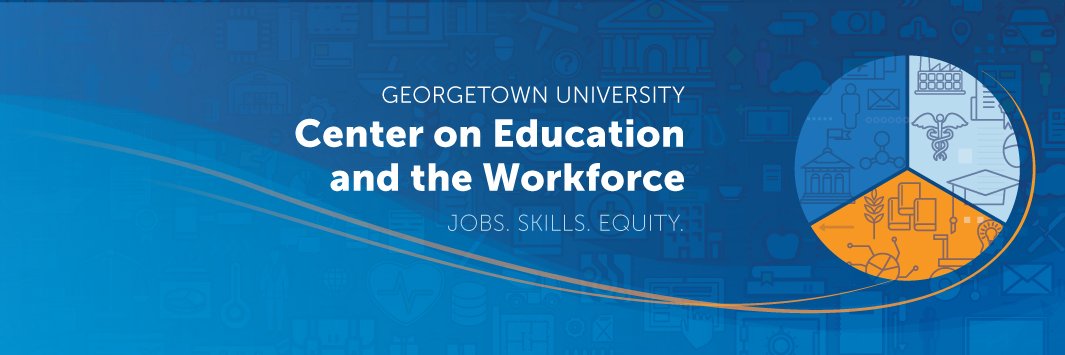
Georgetown CEW
@GeorgetownCEW
The Georgetown University Center on Education and the Workforce (CEW) is a research and policy institute within Georgetown’s McCourt School of Public Policy.
The US is facing shortages of middle-skills credentials that provide pathways for early-career workers without a bachelor’s degree to secure jobs in high-paying occupations. More in our new report: bit.ly/3F98McL

Ideally, potential students would study the #ROI data for various colleges and majors with a counselor. Helping potential students determine a college program’s financial worth is one reason why we need a comprehensive career counseling system. bit.ly/3yA0Idk

Much could change between now and 2031. Despite the many unknowns, our projections consistently point towards continued growth in good jobs. By 2031, there will be 15.2 million more good jobs than there were in 2021. bit.ly/3YeUD4U

Our projections show that the future good jobs landscape will favor workers who have higher levels of education and training. The number of good jobs on the bachelor’s degree pathway will grow by 37% by 2031, resulting in 15.6 million additional good jobs. bit.ly/3YeUD4U

While there will be good jobs on every educational pathway in 2031, access to the greatest economic opportunity will increasingly be tied to postsecondary education and training. bit.ly/3YeUD4U

Construction and extraction occupations will add 893,000 net new good jobs on the middle-skills pathway, while the number of good jobs on the high school pathway in these occupations will decline by 421,000. bit.ly/3YeUD4U

High-paying protective services occupations generally lack diversity. The majority of the protective services workforce is male, and this trend is more pronounced in high-paying protective services occupations, where men account for 90% of workers. bit.ly/3F98McL

By 2031, only 36% of all jobs on the high school pathway will be good compared to 79% on the bachelor's degree pathway and 52% on the middle-skills pathway. bit.ly/3YeUD4U

Upskilling is on the rise: the greatest job growth will occur in occupations in which workers need higher levels of education, and many occupations will require more education than they did in the past. bit.ly/3YeUD4U

“While there is growing doubt about the value of college, our findings indicate that the bachelor’s degree pathway will be the dominant route to a good job in 2031,” said CEW’s Catherine Morris. bit.ly/3YeUD4U

While there will be good jobs on every educational pathway in 2031, only 15% will be available to workers on the high school pathway, compared to 66% to workers on the bachelor's degree pathway and 19% on the middle-skills pathway. bit.ly/3YeUD4U

Economic opportunity will increasingly favor workers with higher levels of education and training. Read our report to find our projections for good jobs in 2031: bit.ly/3YeUD4U

The #ROI for low-income students at some for-profit institutions that predominantly grant certificates is higher than at some public and private nonprofit institutions, especially at for-profit institutions that have a specialized or technical focus. bit.ly/3yA0Idk

We need a system that results in equitable outcomes for students and gives them better info about college & career choices. Low-income students have the deck stacked against them. We need to correct this deficit and move toward an all-one-system approach. bit.ly/3yA0Idk

Hispanic/Latino men, white men, and multiracial men are overrepresented in high-paying STEM occupations relative to their credentials, while Black/African American men and women are underrepresented. bit.ly/3F98McL

Low-income students comprise more than one-third of college students. Where do they get the best #ROI? Our analysis provides a breakdown of which schools are the best investment. Read more here: bit.ly/3yA0Idk

Low-income students get the highest #ROI at the colleges where they pay the least. Public institutions, which usually have lower prices than private nonprofit or for-profit institutions, have a high ROI for low-income students at all degree levels. bit.ly/3yA0Idk

The US will face an annual shortage of 712K middle-skills credentials until at least 2032. Filling these shortages in high-paying middle-skills occupations in an equitable way could improve our economy and quality of life. More from @universitybiz: universitybusiness.com/how-one-big-st…

ROI is not the only measure of a college education’s value, but it’s important to consider. Many students, particularly from low-income families, struggle to pay for college, so ROI may be a critical factor in their decision of whether and where to go. bit.ly/3yA0Idk

Middle-skills providers must significantly increase their production of certificates and associate’s degrees to address impending shortages of locally produced credentials that align with high-paying middle-skills occupations. bit.ly/3MpoAIc

Attending public colleges that predominantly grant bachelor’s degrees results in the best overall outcomes for low-income students, but that does not mean that any given public four-year college is the best choice for a specific low-income student. bit.ly/3yA0Idk
